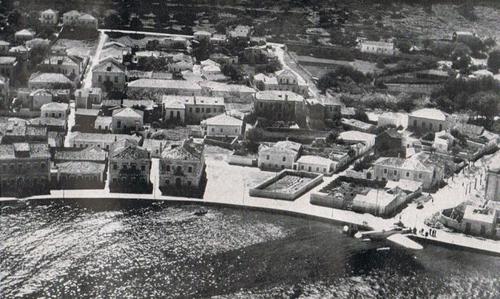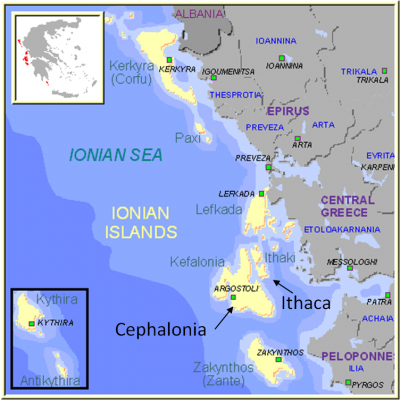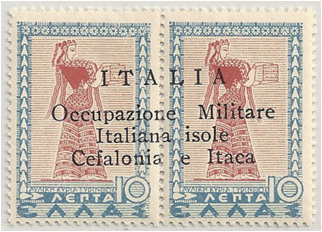ALBUM – view my Italian Occupation of the Cephalonia and Ithaca album
TRANSITION CHART for the Ionian Islands
Fast Facts
Region: Aegean / Ionian Sea
Group: World War 2 Occupations
Classification: Military Occupation
Prior Regime: Kindom of Greece.
Key Dates:
1940, Oct – Italy first attemped to invade Greece from Albania, but were driven back by the Greek Army
1941, Apr – Germany and Italy invade Greece including Crete, the Ionian and Aegean Islands.
1943, Sep 14 – Facist Italy fell and Nazi Germans invaded and took control of the Ionian Islands
1944, Oct 14 – The British Marines liberated Corfu and the Ionian Islands from the Germans
Following Regime: Italian Occupation of the Ionian Islands
Scott Catalogue: (Ionian Islands) #N1-N17, NC1-NC11, NRA1-NRA5
Pick Catalogue: (Greece, Italian Occupation of the Ionian Islands) #M11-M18
Currency: 100 centimes = 1 Italian Lira
History

In the 1800s, the islands were a British Protectorate, and were transferred to Greek rule in 1862. As World War 2 began, Italy initially invaded Greece in October 1940, but the invasion was halted after the Greek army was able to push the Italian army back into Albania. This forced the Germans, allies of Fascist Italy, to shift military plans in the north and come to the aid of Italy. The combined forces were able to engage the Greek forces in April 1941, and by the middle of May, Greece was occupied by the Nazis. While Germany occupied and administered the important cities, such as Athens and Thessaloniki, the Bulgarians controlled the eastern portion of the country, while Italy controlled the majority of the Peloponnesian peninsula, including the Ionian Islands.
 Cephalonia and Ithaca are located of western coast of Greece. Cephalonia (Kefalonia) was taken by a small contigent of Italian forces on 30 April, 1941, and Ithaca was taken the next day on May 1st.
Cephalonia and Ithaca are located of western coast of Greece. Cephalonia (Kefalonia) was taken by a small contigent of Italian forces on 30 April, 1941, and Ithaca was taken the next day on May 1st.
After the full occupation of Greece was complete, the Italians ruled the Ionian Islands as a separate entity from the rest of Greece with the 33rd Infantry Division ‘Acqui’, who together with Navy personnel totaled some 12,000 men. Several times during the occupation, the Italians propsed annexation of the islands into Italy, but none was actually carried out during the war due to pressure from the King of Italy, Victor Emmanuel III, and from the Germans, who were concerned of further alienating the Greek population, which was already strongly opposing the Bulgarian annexations.
On 14 September 1943, after fascism fell in Italy, the Nazis attacked Corfu, bombarding island. The Italians surrendered and the Germans occupied Corfu and the rest of the Ionian Islands. On Cephalonia, General Antonio Gandin, commander of the 12,000-strong Italian Division decided to resist the German attempt to forcibly disarm his force. The battle raged from 13–22 September, but the Italians were defeated. After the Italians surrendered, the German army massacred approximately 5,000 Italian prisoners of war, which stands as one of the worst single war crimes committed by the Nazi’s.
In early June 1944, while the Allies bombed Corfu as a diversion from the Normandy landings, the Gestapo rounded up the Jews of the city and temporarily incarcerated them in the old fortress. On the 10th of June they sent them to Auschwitz where very few survived. Ultimately the Ionian Islands were liberated on 14 October 1944 by the British Royal Marines.
Stamps
 ALBUM
ALBUM
At beginning of the Italian Occupation of the Ionian Islands, the occupational forces took existing stocks of Greek stamps on the islands and overprinted them with “Cefalonia & Itaca” for use on those two islands. (Overprints for Corfu and Zante were also issued on those islands.) For Cephalonia and Ithaca, pairs of Greek stamps were overprinted “ITALIA / Occupazione Militare / Italiana isole / Cefalonia e Itaca” These stamps were issued in June 1941.
In August 1941, Italian stamps (regular postage, air post and postage due) with the overprint of “Isole Jonie”, Italian for Ionian Islands replaced the overprinted Greek stamps. These stamps were used across the islands for postage.
Banknotes
During the occupation, a series of 7 Isole Jonie banknotes featuring various Roman scenes and images were issued. The denominations were: 1, 5, 10, 50, 100, 500, 1.000, and 5.000 drachmai. The banknotes were replaced with German Occupation notes in 1943.
Links
Ionian Islands from Wikipedia
Axis Occupation of Greece in WW2 from Wikipedia
Massacre of the Acqui Division from Wikipedia
Postage Stamps and Postal History of Greece





Michael
Interesting that we are both on the Ionian islands at the moment, although, since my blog stops at 1940, I have the much easier time of it. 😉
I also read of the 5,000 Italian POW massacre, and was absolutely appalled – I had no idea.
The occupation stamps for the “Cefelonia e Itaca” have a high CV. The Italy area, in particular, seems rather expensive to collect- especially for a WW classical generalist. 😉 But you have a nice substantial representative collection, which is a delight to view.
I have meant to tell you earlier how much I am enjoying your “Dead Countries” excursion into the Ionian islands. Very informative and well written.
Jim
Thanks Jim.
These Islands are very interesting as they have been a coveted location for more than 2000 years and were very strategic to much of the sea trade between the east and west. I have put up most of the Ionian Island specific issues and have two more to go. The first being the Italian Occupation of Corfu and Paxos in ww2, which I am working on. The second is the German Occupation of ww2 (commonly called the Zante issues); I don’t have any of these issues, so this entry will have to wait for a while.
I am currently working my way through a Greek collection I bought not too long ago at an auction, primarily because it had a wonderful collection of the various occupational issues (e.g. Thrace, Epirus, Lemnos, Turkish Occupation, and much much more). The Cephalonia and Ithaca issues were part of that collection. Ultimately I will trade or sell the rest of the Greek collection, which is still quite substantial.
Michael